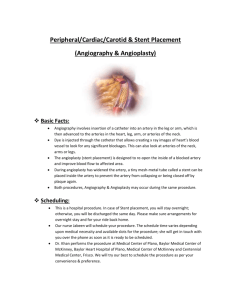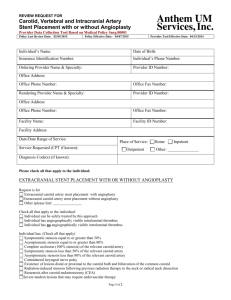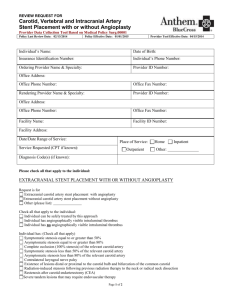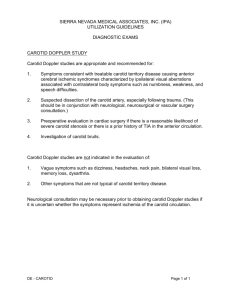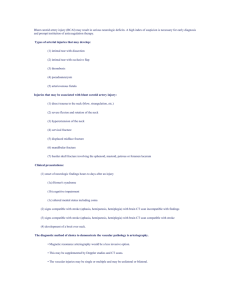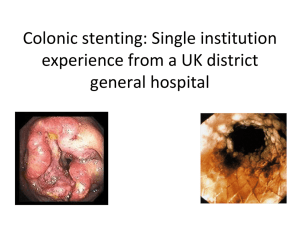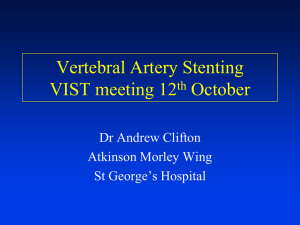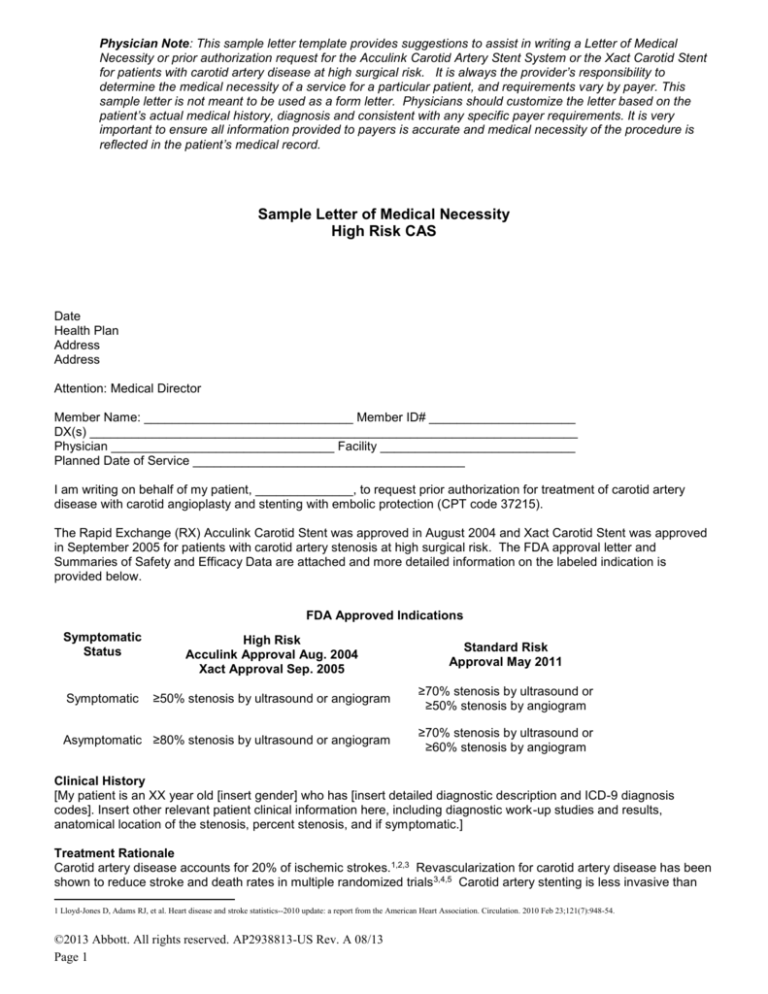
Physician Note: This sample letter template provides suggestions to assist in writing a Letter of Medical
Necessity or prior authorization request for the Acculink Carotid Artery Stent System or the Xact Carotid Stent
for patients with carotid artery disease at high surgical risk. It is always the provider’s responsibility to
determine the medical necessity of a service for a particular patient, and requirements vary by payer. This
sample letter is not meant to be used as a form letter. Physicians should customize the letter based on the
patient’s actual medical history, diagnosis and consistent with any specific payer requirements. It is very
important to ensure all information provided to payers is accurate and medical necessity of the procedure is
reflected in the patient’s medical record.
Sample Letter of Medical Necessity
High Risk CAS
Date
Health Plan
Address
Address
Attention: Medical Director
Member Name: ______________________________ Member ID# _____________________
DX(s) ______________________________________________________________________
Physician ________________________________ Facility ____________________________
Planned Date of Service _______________________________________
I am writing on behalf of my patient, ______________, to request prior authorization for treatment of carotid artery
disease with carotid angioplasty and stenting with embolic protection (CPT code 37215).
The Rapid Exchange (RX) Acculink Carotid Stent was approved in August 2004 and Xact Carotid Stent was approved
in September 2005 for patients with carotid artery stenosis at high surgical risk. The FDA approval letter and
Summaries of Safety and Efficacy Data are attached and more detailed information on the labeled indication is
provided below.
FDA Approved Indications
Symptomatic
Status
High Risk
Acculink Approval Aug. 2004
Xact Approval Sep. 2005
Standard Risk
Approval May 2011
Symptomatic
≥50% stenosis by ultrasound or angiogram
≥70% stenosis by ultrasound or
≥50% stenosis by angiogram
Asymptomatic ≥80% stenosis by ultrasound or angiogram
≥70% stenosis by ultrasound or
≥60% stenosis by angiogram
Clinical History
[My patient is an XX year old [insert gender] who has [insert detailed diagnostic description and ICD-9 diagnosis
codes]. Insert other relevant patient clinical information here, including diagnostic work-up studies and results,
anatomical location of the stenosis, percent stenosis, and if symptomatic.]
Treatment Rationale
Carotid artery disease accounts for 20% of ischemic strokes.1,2,3 Revascularization for carotid artery disease has been
shown to reduce stroke and death rates in multiple randomized trials 3,4,5 Carotid artery stenting is less invasive than
1 Lloyd-Jones D, Adams RJ, et al. Heart disease and stroke statistics--2010 update: a report from the American Heart Association. Circulation. 2010 Feb 23;121(7):948-54.
©2013 Abbott. All rights reserved. AP2938813-US Rev. A 08/13
Page 1
surgery. The 2011 National practice guidelines endorsed by all relevant medical specialties recommend stenting as a
treatment option.3.
Data from multiple pivotal high surgical risk clinical trials and post-market studies (ARCHeR, SECuRITY, CAPTURE,
CAPTURE 2, EXACT, and PROTECT6,7,8,9,10,11,12,13,14) demonstrate the safety of carotid stenting. In the time since the
FDA approvals, event rates (death, stroke, and MI) have consistently decreased and are consistent with AHA
guidelines set for standard risk patients. Decrease in periprocedural event rates is due to advancement in technology,
increasing operator experience, and better patient selection. Patients indicated for carotid artery stenting who are at
high risk for surgery have no other interventional options.
Written authorization should be faxed to ____________________. If you have any questions please do not hesitate
to contact me.
Sincerely,
Physician Name, Title, and Institution
2 White H, Boden-Albala B, Wang C, et al. Ischemic stroke subtype incidence among whites, blacks, and Hispanics: the Northern Manhattan Study. Circulation. 2005;111:1327–31.
3 Brott TG et al. 2011 ASA/ACCF/AHA/AANN/AANS/ACR/ASNR/CNS/SAIP/SCAI/SIR/SNIS/SVM/SVS Guideline on the Management of Patients With Extracranial Carotid and Vertebral Artery
Disease: A Report of the ACCF/AHA Task Force on Practice Guidelines, and the American Stroke Association, American Association of Neuroscience Nurses, American Association of Neurological
Surgeons, American College of Radiology, American Society of Neuroradiology, Congress of Neurological Surgeons, Society of Atherosclerosis Imaging and Prevention, Society for Cardiovascular
Angiography and Interventions, Society of Interventional Radiology, Society of NeuroInterventional Surgery, Society for Vascular Medicine, and Society for Vascular Surgery. Circulation 2011.
4 Chaturvedi et al. Carotid Endarterectomy – An evidence–based review, Neurology 2005; 65: 794-801.
5 Haliday A et al. Prevention of disabling and fatal strokes by successful carotid endarterectomy in patients without recent neurological symptoms: an RCT. Lancet 2004; 363: 1491–1502.
6 Gray WA, Hopkins LN, Yadav S, Davis T, Wholey M, Atkinson R, Cremonesi A, Fairman R, Walker G, Verta P, Popma J, Virmani R, Cohen DJ; ARCHeR Trial
Collaborators. Protected carotid stenting in high-surgical-risk patients: the ARCHeR results. J Vasc Surg. 2006 Aug;44(2):258-68. Erratum in: J Vasc Surg. 2007 Jan;45(1):226. PubMed PMID:
16890850.
7 Gray WA, Yadav JS, Verta P, Scicli A, Fairman R, Wholey M, Hopkins LN, Atkinson R, Raabe R, Barnwell S, Green R. The CAPTURE registry: results of carotid stenting with embolic protection
in the post approval setting. Catheter Cardiovasc Interv. 2007 Feb 15;69(3):341-8. PubMed PMID: 17171654.
8 Fairman R, Gray WA, Scicli AP, Wilburn O, Verta P, Atkinson R, Yadav JS, Wholey M, Hopkins LN, Raabe R, Barnwell S, Green R; for the CAPTURE Trial Collaborators. The CAPTURE
registry: analysis of strokes resulting from carotid artery stenting in the post approval setting: timing, location, severity, and type. Ann Surg. 2007 Oct;246(4):551-6; discussion 556-8. PubMed PMID:
17893491.
9 Gray WA, Yadav JS, Verta P, Scicli A, Fairman R, Wholey M, Hopkins LN, Atkinson R, Raabe R, Barnwell S, Green R; CAPTURE Trial Collaborators. The CAPTURE registry: predictors of
outcomes in carotid artery stenting with embolic protection for high surgical risk patients in the early post-approval setting. Catheter Cardiovasc Interv. 2007 Dec 1;70(7):1025-33. PubMed PMID:
18044758.
10 Gray WA, Chaturvedi S, Verta P; Investigators and the Executive Committees. Thirty-day outcomes for carotid artery stenting in 6320 patients from 2 prospective, multicenter, high-surgical-risk
registries. Circ Cardiovasc Interv. 2009 Jun;2(3):159-66. Epub 2009 Mar 6. PubMed PMID: 20031712.
11 Chaturvedi S, Matsumura JS, Gray W, Xu C, Verta P; CAPTURE 2 Investigators and Executive Committee. Carotid artery stenting in octogenarians: periprocedural stroke risk predictor analysis
from the multicenter Carotid ACCULINK/ACCUNET Post Approval Trial to Uncover Rare Events (CAPTURE 2) clinical trial. Stroke. 2010 Apr;41(4):757-64. Epub 2010 Feb 25. PubMed PMID:
20185789.
12 Matsumura JS, Gray W, Chaturvedi S, Gao X, Cheng J, Verta P; CAPTURE 2 Investigators and Executive Committee. CAPTURE 2 risk-adjusted stroke outcome benchmarks for carotid artery
stenting with distal embolic protection. J Vasc Surg. 2010 Sep;52(3):576-83, 583.e1-583.e2. Epub 2010 Jun 23. PubMed PMID: 20576398.
13 Gray WA, Rosenfield KA, Jaff MR, Chaturvedi S, Peng L, Verta P; CAPTURE 2 Investigators and Executive Committee. Influence of site and operator characteristics on carotid artery stent
outcomes: analysis of the CAPTURE 2 (Carotid ACCULINK/ACCUNET Post Approval Trial to Uncover Rare Events) clinical study. JACC Cardiovasc Interv. 2011 Feb;4(2):235-46. PubMed PMID:
21349464.
14 Matsumura J, Gray WA, Chaturvedi S, Yamanouchi D,Peng L, Verta P. Results of Carotid Artery Stenting with Distal Embolic Protection with Improved Systems (PROTECT). Conditionally
accepted for publication on May 26, 2011 by JSV.
©2013 Abbott. All rights reserved. AP2938813-US Rev. A 08/13
Page 2
Disclaimer
Hospitals, physicians and other health care providers are responsible for selecting the CPT, HCPCS, or ICD-9-CM
codes that most accurately reflect the procedures performed, products used, and patient conditions.
Such codes must also be selected and reported on claims forms consistent with the patient's insurer/health care
payer's requirements, including the use of modifiers. The coding information provided here is for informational
purposes.
Abbott makes no representation or warranty regarding the completeness, accuracy, or timeliness of information
provided here. Payor policies vary from plan to plan, and change over time. Hospitals, physicians and health care
providers should check with complete listings of CPT, HCPCS and other codes from authoritative sources, such as the
AMA CPT 2011 (Professional Edition), and with CMS national and local Medicare policies from Medicare
administrative contractors (MACs) - fiscal intermediaries and carriers, including the policies of the particular patient's
health insurance program.
Abbott does not guarantee that the use of any codes presented here will result in coverage or payment at any
particular level. Abbott will not reimburse hospitals or physicians for claims denied by health insurers/payers. The
codes and Medicare policies presented here are offered to provide a list of codes potentially applicable to many of the
different peripheral and carotid procedures in clinical use. It is not intended to be an exhaustive list of all the potentially
applicable codes for all procedures.
Abbott Product Information
Any questions or comments about Abbott products or codes and Medicare policies that may be applicable to Abbott
products should be directed to the Abbott Vascular Reimbursement Hotline (1-800-354-9997). Product information
including FDA approved or cleared indications for Abbott Vascular products is provided in accordance with Abbott
policies and FDA.
Revascularization for carotid artery disease has been shown to reduce stroke and death rates in multiple randomized
trials3,15,16 Carotid artery stenting is less invasive than surgery. The 2011 national practice guidelines endorsed by all
relevant medical specialties recommend stenting as an appropriate treatment option. 3
CREST is a major NIH-sponsored randomized clinical trial comparing the safety and effectiveness of carotid artery
stenting compared with carotid endarterectomy in 2,500 patients in symptomatic and asymptomatic patients. The
results of the CREST NIH analysis were published in the New England Journal of Medicine and demonstrated that
carotid artery stenting with the Acculink Carotid Stent System and Accunet Embolic Protection System was safe and
effective in treating carotid artery disease for standard surgical risk subjects with carotid artery disease. 17
15 Chaturvedi et al. Carotid Endarterectomy – An evidence–based review, Neurology 2005; 65: 794-801.
16 Haliday A et al. Prevention of disabling and fatal strokes by successful carotid endarterectomy in patients without recent neurological symptoms: an RCT. Lancet 2004; 363: 1491–1502.
17 Brott TG for the CREST Investigators.Stenting versus endarterectomy for treatment of carotid-artery stenosis. N Engl J Med. 2010 Jul 1;363(1):11-23.
©2013 Abbott. All rights reserved. AP2938813-US Rev. A 08/13
Page 3
RX Acculink®
Carotid Stent System
INDICATIONS
The RX Acculink Carotid Stent System, used in conjunction with the Abbott Vascular embolic protection system specified below, is indicated for
the treatment of patients at high and standard risk for adverse events from carotid endarterectomy who require carotid revascularization and meet
the criteria outlined below:
High Risk
Embolic Protection System
With neurological symptoms
Without neurological symptoms
Reference vessel diameter
Standard Risk
Abbott Vascular’s Accunet or Emboshield Family
≥ 50% stenosis of the common or
≥ 70% stenosis of the common or
internal carotid artery by
internal carotid artery by
ultrasound or angiogram
ultrasound or ≥ 50% stenosis of
the common or internal carotid
artery by angiogram
≥ 80% stenosis of the common or
≥ 70% stenosis of the common or
internal carotid artery by
internal carotid artery by
ultrasound or angiogram
ultrasound or ≥ 60% stenosis of
the common or internal carotid
artery by angiogram
Must be within 4.0 mm – 9.0 mm at the target lesion
CONTRAINDICATIONS
The RX Acculink Carotid Stent System is contraindicated for use in:
• Patients in whom anti-coagulant and / or anti-platelet therapy is contraindicated.
• Patients with severe vascular tortuosity or anatomy that would preclude the safe introduction of a guide catheter, sheath, embolic protection
system, or stent system.
• Patients with known hypersensitivity to nickel-titanium.
• Patients with uncorrected bleeding disorders.
• Lesions in the ostium of the common carotid artery.
WARNINGS
Only physicians who have received appropriate training and are familiar with the principles, clinical applications,
complications, side effects and hazards commonly associated with carotid stent placement should use this device.
General
Refer to the Instructions for Use supplied with any interventional devices to be used in conjunction with the RX Acculink Carotid Stent System
for their intended uses, contraindications, and potential complications.
The safety and efficacy of the RX Acculink Carotid Stent System have not been demonstrated with embolic protection systems other than Abbott
Vascular’s Accunet or Emboshield family of Embolic Protection Systems (EPS). Refer to the Instructions for Use document for the Embolic
Protection System that will be used for specific device instructions.
Clinical study results suggest lower event rates when the RX Acculink Carotid Stent System is used in conjunction with an embolic protection
device.
The long-term performance (> 3 years) of the Acculink Carotid Stent has not been established.
As with any type of vascular implant, infection secondary to contamination of the stent may lead to thrombosis, pseudoaneurysm, or rupture.
Stenting across a major bifurcation may hinder or prevent future diagnostic or therapeutic procedures.
In patients requiring the use of antacids and / or H2-antagonists before or immediately after stent placement, oral absorption of antiplatelet agents
(e.g. aspirin) may be adversely affected.
The appropriate antiplatelet and anticoagulation therapy should be administered pre- and postprocedure as suggested in these instructions. Special
consideration should be given to those patients with recently active gastritis or peptic ulcer disease.
When multiple stents are required, stent materials should be of similar composition.
Patient Selection
The safety and effectiveness of the RX Acculink Carotid Stent System have NOT yet been established in patients with the characteristics noted
below.
Patient Characteristics:
• Patients experiencing acute ischemic neurologic stroke or who experience a stroke within 7 days prior to the procedure • Patients with an
intracranial mass lesion (i.e., abscess, tumor, or infection) or aneurysm > 5 mm • Patients with arteriovenous malformations of the territory of the
target carotid artery • Patients with coagulopathies • Patients with poor renal function who, in the physician’s opinion, may be at high risk for a
reaction to contrast medium • Patients with perforated vessels evidenced by extravasation of contrast media • Patients with aneurysmal dilation
immediately proximal or distal to the lesion • Pregnant patients or patients under the age of 18.
©2013 Abbott. All rights reserved. AP2938813-US Rev. A 08/13
Page 4
Lesion Characteristics:
• Patients with evidence of intraluminal thrombus thought to increase the risk of plaque fragmentation and distal embolization
• Patients whose lesion(s) may require more than two stents • Patients with total occlusion of the target vessel • Patients with highly calcified
lesions resistant to PTA.
Access Characteristics:
• Patients with known peripheral vascular, supra-aortic or internal carotid artery tortuosity that would preclude the use of catheter-based
techniques • Patients in whom femoral access is not possible • Risk of distal embolization may be higher if the RX Acculink Carotid System
cannot be used in conjunction with an embolic protection system during the carotid stenting procedure.
The safety and effectiveness of concurrent treatment of lesions in patients with bilateral carotid artery disease have not been established.
DEVICE USE
This device is intended for single-use only. Do not reuse. Do not resterilize, as this can compromise device performance and increase the risk of
cross contamination due to inappropriate reprocessing.
Do not use the product after the "Use By" date specified on the package.
Do not use the product if the temperature indicator on inner pouch is black.
Maintain the patient’s Activated Clotting Time (ACT) at > 250 seconds throughout RX Acculink Carotid Stent System usage to prevent
thrombus formation on the device.
Maintain continuous flush while removing and reinserting devices on the guide wire. Perform all exchanges slowly to prevent air embolism or
trauma to the artery.
Caution should be used if pre-dilating the lesion without embolic protection as this may increase the risk of an adverse outcome.
Implanting a stent may lead to dissection of the vessel distal and / or proximal to the stent and may cause acute closure of the vessel, requiring
additional intervention (carotid endarterectomy, further dilatation, or placement of additional stents).
The stent may cause a thrombus, distal embolization or may migrate from the site of implant down the arterial lumen. Appropriate sizing of the
stent to the vessel is required to reduce the possibility of stent migration. In the event of thrombosis of the expanded stent, thrombolysis and PTA
should be attempted.
In the event of complications such as infection, pseudoaneurysm or fistulization, surgical removal of the stent may be required.
Overstretching of the artery may result in rupture and life-threatening bleeding.
If a filter-based embolic protection system (EPS) is used, allow for and maintain adequate distance between the RX Acculink Carotid Stent
System and the EPS to avoid potential filter engagement with the RX Acculink Carotid Stent System tip and / or filter entanglement with the
deployed stent. If filter engagement and / or entanglement or filter detachment occurs, surgical conversion or additional catheter based
intervention may be required.
Ensure optimal positioning of the stent prior to deployment. Once deployment is initiated, the stent cannot be repositioned or recaptured. Stent
retrieval methods (use of additional wires, snares and / or forceps) may result in additional trauma to the carotid vasculature and / or the vascular
access site. Complications may include death, stroke, bleeding, hematoma or pseudoaneurysm.
PRECAUTIONS
Stent Handling – Precautions
Carefully inspect the RX Acculink Carotid Stent System to verify that the device has not been damaged in shipment. Do not use damaged
equipment.
The delivery system has an internal hypotube. Take care to avoid unnecessary handling, which may kink or damage the delivery system. Do not
use if device is kinked.
Do not expose the delivery system to organic solvents (e.g. alcohol) as structural integrity and / or function of the device may be impaired.
Do not remove the stent from its delivery system as removal may damage the stent. The stent on the delivery system is intended to perform as a
system. If removed, the stent cannot be put back on the delivery system.
The delivery system should not be used in conjunction with other stents.
Special care must be taken not to handle or in any way disrupt the stent on the delivery system.
This is most important during catheter removal from packaging, mandrel removal, placement over the guide wire, and advancement through a
Rotating Hemostatic Valve (RHV) adapter and guiding catheter hub.
Do not hold the sheath or stent during mandrel removal.
Stent Placement – Precautions
Use with bleedback control hemostatic valves is not recommended.
The RX Acculink Carotid Stent System is not compatible with any guide wire larger than 0.014” (0.36 mm).
Leave the safety lock closed until the stent is ready to deploy.
The RX Acculink Carotid Stent System must be used with a guiding catheter or introducer sheath to maintain adequate support of the 0.014”
guide wire throughout the procedure.
For best device performance, the guide wire exit notch should remain within the guiding catheter or sheath.
Ensure the stent system is fully flushed with heparinized saline prior to use. Do not use the delivery system if flush is not observed exiting at the
distal end of the sheath.
Do not attempt to pull a partially expanded stent back through the guiding catheter or sheath; dislodgment of the stent from the delivery system
may occur.
Venous access should be available during carotid stenting to manage bradycardia and / or hypotension by either pharmaceutical intervention or
placement of a temporary pacemaker, if needed.
©2013 Abbott. All rights reserved. AP2938813-US Rev. A 08/13
Page 5
When catheters are in the body, they should be manipulated only under fluoroscopy.
Radiographic equipment that provides high quality images is needed.
The delivery system is not designed for use with power injection. Use of power injection may adversely affect device performance.
If resistance is met during delivery system introduction, the system should be withdrawn and another system used.
Prior to stent deployment, remove all slack from the delivery system.
When more than one stent is required to cover the lesion, or if there are multiple lesions, the distal lesion should be stented first, followed by
stenting of the proximal lesion. Stenting in this order obviates the need to cross the proximal stent for placement of the distal stent and reduces
the chance of dislodging stents that have already been placed.
If overlap of sequential stents is necessary, the amount of overlap should be kept to a minimum (approximately 5 mm). In no instance should
more than 2 stents overlap.
Post-Implant – Precautions
Care must be exercised when crossing a newly deployed stent with other interventional devices to avoid disrupting the stent geometry and
placement of the stent.
In the event of thrombosis of the expanded stent, thrombolysis and PTA should be attempted.
POTENTIAL ADVERSE EVENTS
Based on the literature, and on clinical and commercial experience with carotid stents and
embolic protection systems, the following alphabetical list includes possible adverse events
associated with use of these devices:
• Allergic reactions to anti-platelet agents / contrast medium • Aneurysm • Angina / coronary ischemia • Arrhythmia • Arterial occlusion /
thrombosis at puncture site or remote site • Arteriovenous fistula • Bacteremia or septicemia • Bleeding from anticoagulant or antiplatelet
medications • Cerebral edema • Cerebral hemorrhage • Cerebral ischemia / transient ischemic attack (TIA) • Congestive heart failure (CHF) •
Death • Detachment and / or implantation of a component of the system • Emboli, distal (air, tissue or thrombotic emboli) • Emergent or urgent
endarterectomy surgery (CEA) • Fever • Filter thrombosis / occlusion • Groin hematoma, with or without surgical repair • Hemorrhage, with or
without transfusion • Hyperperfusion syndrome • Hypotension / hypertension • Infection and pain at insertion site • Ischemia / infarction of tissue
/ organ • Myocardial infarction (MI) • Pain (head, neck) • Pseudoaneurysm, femoral • Renal failure / insufficiency • Restenosis of stented
segment • Seizure • Severe unilateral headache • Stent / filter entanglement / damage • Stent embolization • Stent malposition • Stent migration •
Stent thrombosis / occlusion • Stroke / cerebrovascular accident (CVA) • Total occlusion of carotid artery • Vessel dissection, perforation, or
rupture
• Vessel spasm or recoil
Prior to use, please reference the Instructions for Use at www.abbottvascular.com for more information on indications, contraindications,
warnings, precautions, and adverse events.
Acculink is a trademark of the Abbott Group of Companies.
©2013 Abbott. All rights reserved. AP2938813-US Rev. A 08/13
Page 6
Xact® Carotid Stent System
INDICATIONS
The Xact Carotid Stent System (Xact), used in conjunction with the Emboshield Embolic Protection System is indicated for the
improvement of the lumen diameter of carotid arteries in patients considered at high risk for adverse events from carotid
endarterectomy who require percutaneous carotid angioplasty and stenting for occlusive artery disease and meet the criteria outlined
below:
Patients with carotid artery stenosis (≥ 50% for symptomatic patients by ultrasound or angiography or ≥ 80% for asymptomatic patients
by ultrasound or angiography), located between the origin of the common carotid artery and the intra-cranial segment of the internal
carotid artery AND
Patients must have a reference vessel diameter ranging between 4.8 mm and 9.1 mm at the target lesion.
CONTRAINDICATIONS
Contraindications associated with angioplasty must be considered when using the Xact Carotid Stent System. These include, but are not
limited to:
• Patients in whom anticoagulant and / or antiplatelet therapy is contraindicated.
• Patients with severe vascular tortuosity or anatomy that would preclude the safe introduction of the Guiding Catheter / Introducer
Sheath, BareWire guide wire, Emboshield Delivery Catheter, Filtration Element, and / or Retrieval Catheter.
• Patients with a known hypersensitivity to nickel-titanium.
• Patients with uncorrected bleeding disorders.
• Lesions in the ostium of the common carotid artery.
WARNINGS
Only physicians who have received appropriate training and are familiar with the principles, clinical applications,
complications, side effects and hazards commonly associated with carotid interventional procedures should use this device.
General
Refer to instructions supplied with all interventional devices to be used with the Xact Carotid Stent System for their intended uses,
contraindications, and potential complications.
The safety and efficacy of the Xact Carotid Stent System has not been demonstrated with embolic protection systems other than the
Emboshield Embolic Protection System.
The long-term performance (> 1 year) of the Xact Carotid Stent System has not been established.
As with any type of vascular implant, infection secondary to contamination of the stent may lead to thrombosis, pseudoaneurysm, or
rupture.
Stenting across a major bifurcation may hinder or prevent future diagnostic or therapeutic procedures.
In patients requiring the use of antacids and / or H2-antagonists before or immediately after stent placement, oral absorption of
antiplatelet agents (e.g. aspirin) may be adversely affected.
The appropriate antiplatelet and anticoagulation therapy should be administered pre- and post-procedure as suggested in these
instructions. Special consideration should be given to those patients with recently active gastritis or peptic ulcer disease.
When multiple stents are required, stent materials should be of similar composition.
The safety and effectiveness of the Xact Carotid Stent System has NOT yet been established in patients with the characteristics noted
below.
• Low to moderate risk for adverse events from carotid endarterectomy.
• Previously placed stent in target artery.
• Total occlusion of target lesion.
• Angiographically visible thrombus.
• Carotid string sign (a tiny, long segment of contrast in the true lumen of the artery).
• Vessel anatomy precluding the use of the stent system or appropriate positioning of the embolic protection system.
• Presence of carotid artery dissection prior to initiation of the procedure.
• Evidence of a stroke within the previous 30 days.
• History of ipsilateral stroke with fluctuating neurologic symptoms within 1 year.
• History of intracranial hemorrhage within the past 3 months.
• Any condition that precluded proper angiographic assessment or made percutaneous arterial access unsafe, (e.g. morbid obesity,
sustained systolic blood pressure > 180 mmHg).
• Contraindication to aspirin, or to clopidogrel AND ticlopidine, or stent material.
• History or current indication of bleeding diathesis or coagulopathy including thrombocytopenia or an inability to receive heparin in
amounts sufficient to maintain an activated clot time at > 250 seconds.
©2013 Abbott. All rights reserved. AP2938813-US Rev. A 08/13
Page 8
• Hemoglobin (Hgb) < 8 gm / dl (unless on dialysis), platelet count < 50,000, INR > 1.5 (irreversible), or heparin-associated
thrombocytopenia.
• Known cardiac sources of emboli.
• Atherosclerotic disease involving adjoining vessels precluding safe placement of the guiding catheter or sheath.
• Other abnormal angiographic findings that indicated the patient was at risk of a stroke due to a problem other than that of the target
lesion, such as: ipsilateral arterial stenosis greater in severity than the target lesion, cerebral aneurysm, or arteriovenous malformation
of the cerebral vasculature.
• Severe dementia.
• Life threatening allergy to contrast media that could not be treated.
• Pregnant patients or patients under the age of 18.
• Patients in whom femoral access is not possible.
• Patients with aneurysmal dilation immediately proximal or distal to the lesion.
The safety and effectiveness of concurrent treatment of lesions in patients with bilateral carotid artery disease have not been
established.
PRECAUTIONS
Carefully inspect device components prior to use to verify that they have not been damaged and that the size, shape and condition are
suitable for the procedure for which they are to be used. A device or access device which is kinked or damaged in any way should not
be used. If pouch is damaged do not use.
Confirm the compatibility of the Xact Stent Delivery System with the interventional devices before actual use.
Precautions to prevent or reduce clotting should be taken when any interventional device is used. Flush or rinse all devices entering the
vascular system with sterile isotonic Heparinized saline prior to use.
Do not remove the stent from its delivery system as removal may damage the stent. The stent and delivery system are intended to be
used in tandem. If removed, the stent cannot be put back on the delivery system.
The delivery system should not be used in conjunction with other stents.
To reduce the potential for the liberation of emboli during lesion crossing, the device should be carefully manipulated and not advanced
against resistance.
During stent placement, 1.5 cm of vessel should be left between the distal margin of the stent and the Filtration Element. The stent
delivery system should not contact the Filtration Element.
Venous access should be available during carotid stenting in order to manage bradycardia and/or hypotension by either pharmaceutical
intervention or placement of a temporary pacemaker, if needed.
The device must only be flushed using the 3-ml syringe and flushing tip provided.
The outside diameter of the Outer Sheath is 5.7 Fr. An appropriate sized sheath/guiding catheter should be selected based on this
diameter.
Do not use a prepared Xact Carotid Stent System if the stent is not fully constrained within the Delivery System.
Do not use if the stent is partially deployed.
If, after preparation, a gap between the catheter tip and the outer sheath exists, rotate the Deployment Actuator in an anti-clockwise
direction until the gap is closed.
Advancement and deployment of the Xact Carotid Stent System should only be performed under fluoroscopic observation.
Do not advance any component, or section thereof, of the Xact Carotid Stent System against significant resistance. The cause of any
resistance should be determined via fluoroscopy and remedial action taken.
Do not attempt to reposition the Delivery System once the stent has made contact with the vessel wall.
Do not torque the Xact Carotid Stent System.
If more than one stent is required to cover the lesion, or if there are multiple lesions, the distal lesion should be stented first, followed
by stenting of the proximal lesion.
If overlap of sequential stents is necessary, the amount of overlap should be kept to a minimum.
MRI Information
Non-clinical testing has demonstrated that the Xact Carotid stent is MR Conditional. It can be scanned safely under the conditions
listed in the Instructions for Use.
POTENTIAL ADVERSE EFFECTS
As reported in the literature, the following adverse events are potentially associated with carotid stents and embolic protection systems:
• Abrupt closure • Allergic reactions • Aneurysm • Angina/Coronary ischemia • Arteriovenous Fistula • Bacteremia or septicemia
• Bleeding from anticoagulant or antiplatelet medications • Bradycardia/arrhythmia • Cerebral edema • Cerebral hemorrhage
• Congestive Heart Failure • Death • Drug reactions • Embolism (including air and device) • Emergent or urgent Endarterectomy
• Fever • Filter thrombosis / occlusion • Fluid overload • Groin hematoma, with or without surgical repair • Hemorrhage or hematoma
• Hemorrhagic stroke • Headache • Hypotension • Hyperperfusion syndrome • Hypertension • Infection / sepsis • Ischemia / infarction
of tissue / organ • Myocardial Infarction • Other conduction disturbances • Pain and tenderness • Pain, infection, or discomfort at the
access site • Pseudoaneurysm • Renal failure / insufficiency • Restenosis of the stented artery • Seizure
©2013 Abbott. All rights reserved. AP2938813-US Rev. A 08/13
Page 9
• Stent deformation, collapse, fracture, movement of stent, possibly requiring emergency surgery • Stent / filter entanglement / damage
• Stroke or other neurological complications • Thromboembolic episodes • Thrombophlebitis • Total occlusion of the artery
• Transient ischemic attacks (TIAs) • Vascular access complications (e.g. loss of pulse, femoral artery pseudoaneurysm
and infection) • Ventricular fibrillation • Vessel dissection, rupture, or perforation • Vessel thrombosis (partial blockage) •
Unstable angina pectoris
Prior to use, please reference the Instructions for Use at www.abbottvascular.com for more information on indications,
contraindications, warnings, precautions, and adverse events.
Xact is a trademark of the Abbott Group of Companies.
©2013 Abbott. All rights reserved. AP2938813-US Rev. A 08/13
Page 10
RX Accunet®
Embolic Protection System
INDICATIONS
The RX Accunet EPS is indicated for use as a guide wire and embolic protection system to contain and remove embolic material
(thrombus / debris) while performing angioplasty and stenting procedures in carotid arteries. The diameter of the artery at the site of
filter basket placement should be between 3.25 mm and 7.0 mm.
CONTRAINDICATIONS
The RX Accunet EPS is contraindicated for use in:
• Patients in whom anticoagulant and / or antiplatelet therapy is contraindicated • Patients with severe vascular tortuosity or anatomy
that would preclude the safe introduction of a guiding catheter, sheath, embolic protection system, or stent system • Patients with
known hypersensitivity to nickel-titanium • Patients with uncorrected bleeding disorders.
WARNINGS
Only physicians who have received appropriate training and are familiar with the principles, clinical applications, complications, side
effects and hazards commonly associated with carotid interventional procedures should use this device.
General
Refer to the instructions supplied with all interventional devices to be used in conjunction with the RX Accunet EPS for their intended
uses, contraindications, and potential complications.
The safety and effectiveness of this device as an embolic protection system have not been established in vasculatures outside the
carotid arteries.
The safety and efficacy of the RX Accunet EPS have not been demonstrated with carotid stent systems other than the over-the-wire or
RX Acculink Carotid Stent System.
The appropriate antiplatelet and anticoagulation therapy should be administered pre- and post-procedure as suggested in these
instructions. Special consideration should be given to those patients with recently active gastritis or peptic ulcer disease.
Device Use
This device is intended for single-use only. Do not reuse. Do not resterilize, as this can compromise device performance and increase
the risk of cross contamination due to inappropriate reprocessing.
Do not use the product after the "Use By" date specified on the package.
Maintain the patient’s Activated Clotting Time (ACT) at > 250 seconds throughout RX Accunet EPS usage to prevent thrombus
formation on the device.
During positioning, advance the RX Accunet EPS guide wire with filter basket and the delivery sheath as a unit. Advancing the guide
wire independent of the delivery sheath may result in premature filter deployment.
Always advance or withdraw the RX Accunet EPS guide wire slowly using fluoroscopy to observe corresponding wire movement in
general and tip movement in particular. Never push, auger, retract or torque a guide wire that meets resistance. If the wire tip becomes
entrapped within a lesion or a device, such as a deployed stent, do NOT torque the guide wire. Determine the cause of resistance and
take necessary remedial action. Torquing or retracting the guide wire against resistance may damage the wire, cause wire tip separation,
or cause vessel trauma. Resistance may be felt and / or observed using fluoroscopy by noting any buckling of the guide wire tip.
Maintain continuous flush while removing and reinserting devices on the guide wire. Perform all exchanges slowly to prevent air
embolism or trauma to the artery.
Overstretching of the artery may result in rupture and life-threatening bleeding.
When introducing the delivery system, confirm that the wire tip is free within the vessel lumen and is not directed against the vessel
wall. Failure to do so may result in vessel trauma. Use the radiopaque marker on the interventional device to confirm position.
Avoid excessive movement of the RX Accunet EPS guide wire and filter basket during catheter device exchanges. Excessive
movement of the deployed basket may cause vessel trauma or spasm.
The filter basket must be kept distal to the area to be covered by the stent and proximal to the petrous portion of the carotid artery to
avoid excessive forces on the filter basket.
Allow for and maintain adequate distance between the radiopaque proximal bushing marker on the guide wire with filter basket and the
stent delivery system or other compatible interventional devices to avoid potential entanglement.
Always keep the open filter basket distal to the deployed stent. Do not attempt to pull an open filter basket through the stent. Do not
attempt to capture the filter basket by pulling it into the recovery catheter if the recovery catheter tip is in the stent area. Pulling the
filter basket into the stent area may lead to stent-filter basket entanglement and / or basket detachment. If filter basket entanglement or
detachment occurs, surgical conversion or collapsing the basket with a second stent should be considered.
©2013 Abbott. All rights reserved. AP2938813-US Rev. A 08/13
Page 11
Maintain proper guiding catheter / sheath support in the common carotid artery throughout the procedure. If guiding catheter / sheath
access cannot be maintained, the case should be discontinued. Failure to maintain proper support of the guiding catheter / sheath can
lead to prolapse of the catheter into the aortic arch, resulting in any of the following:
• Movement of an open filter through an undilated lesion; or • Filter-stent entanglement, filter basket detachment and / or proximal
movement of the stent; or • Filter guide wire breakage.
Do not rotate either recovery catheter more than 90 degrees in either direction since this can result in the guide wire wrapping around
the catheter.
Use with fixed (passive) hemostatic valves is not recommended.
If excessive debris is collected in the filter basket such that distal perfusion of dye is significantly reduced or no dye is perfusing past
the filter, the RX Accunet EPS may have reached its maximum capacity to contain emboli. Remove and replace the RX Accunet EPS.
Otherwise, it may be difficult to completely recover all embolic debris and the potential for thrombus formation may increase.
Discard unused RX Accunet and RX Accunet 2 Recovery Catheters after completing procedure. Failure to discard unused recovery
catheters can result in any or all of the following: the use of a device past its “Use By” date; or the use of an incorrectly sized RX
Accunet Recovery Catheter, which can cause loss of particulates from the filter basket during recovery, filter-stent entanglement, filter
basket detachment and / or proximal movement of stent.
PRECAUTIONS
Guide wires are delicate instruments and should be handled carefully. Prior to use and when possible during the procedure, inspect the
guide wire carefully for bends, kinks, or other damage. Do not use damaged guide wires. Using a damaged guide wire may result in
vessel damage and / or inaccurate torque response.
Do not expose the delivery or recovery systems to organic solvents (e.g. alcohol) as structural integrity and / or function of the device
may be impaired.
Confirm the compatibility of the RX Accunet EPS with the interventional devices before actual use.
To avoid air entrapment, do not leave the introducer tool in the valve while advancing the delivery system. Advance the delivery
system slowly through the guiding catheter / sheath.
Ensure that the torque device is secured tightly to the guide wire to avoid difficulties with deployment. If the torque device is not
tightened securely on the guide wire proper deployment may not occur.
For proper positioning of the filter basket, the vessel distal to the lesion should have an absence of excessive tortuosity and be of
adequate length (approximately 4 cm distal to the lesion and proximal to the petrous portion of the vessel).
Reconfirm the filter basket position prior to deployment of the stent to ensure that there is adequate distance between the radiopaque
proximal bushing marker on the guide wire with filter basket and the distal end of the desired stent position. Reposition the filter basket
as necessary by gently advancing the guide wire. Under fluoroscopy, observe movement of the filter basket to the desired position.
Observe all guide wire movement in the vessels using fluoroscopic guidance.
Venous access should be available during carotid stenting in order to manage bradycardia and / or hypotension by either
pharmaceutical intervention or placement of a temporary pacemaker, if needed.
The delivery system is not designed for use with power injection. Use of power injection may adversely affect device performance.
Do NOT deliver the RX Accunet EPS guide wire with filter basket through any interventional devices other than the RX Accunet EPS
delivery sheath.
Removal of the RX Accunet EPS guide wire with filter basket through any interventional devices other than the RX Accunet and RX
Accunet 2 Recovery Catheters has not been tested.
Care must be used when removing the filter basket through a newly deployed stent to maintain filter basket integrity and to avoid
disrupting the stent geometry.
If the RX Accunet EPS is desired for intervention in additional vessels, use a new device.
POTENTIAL ADVERSE EVENTS
Based on the literature, and on clinical and commercial experience with the use of embolic protection systems with a carotid stent, the
following alphabetical list includes possible adverse events associated with the use of this device:
• Allergic reactions to antiplatelet agents / contrast medium • Aneurysm • Angina / coronary ischemia • Arrhythmia • Arterial occlusion
/ thrombosis at puncture site or remote site • Arteriovenous fistula • Bacteremia or septicemia • Bleeding from anticoagulant or
antiplatelet medications • Cerebral edema • Cerebral hemorrhage • Cerebral ischemia / transient ischemic attack (TIA) • Congestive
heart failure (CHF) • Death • Detachment and / or implantation of a component of the system • Emboli, distal (air, tissue, or thrombotic
emboli) • Emergent or urgent endarterectomy surgery (CEA) • Fever • Filter thrombosis / occlusion • Groin hematoma, with or without
surgical repair • Hemorrhage, with or without transfusion • Hypotension / hypertension • Infection and pain at insertion site • Ischemia /
infarction of tissue / organ • Myocardial infarction (MI) • Pain (head, neck) • Pseudoaneurysm, femoral • Renal failure / insufficiency •
Restenosis of stented / dilated vessel • Seizure • Severe unilateral headache • Stent / filter entanglement / damage • Stroke /
cerebrovascular accident (CVA) • Total occlusion of carotid artery • Vessel dissection, perforation, or rupture • Vessel spasm or recoil
Prior to use, please reference the Instructions for Use at www.abbottvascular.com for more information on indications,
contraindications, warnings, precautions, and adverse events.
Accunet is a trademark of the Abbott Group of Companies.
©2013 Abbott. All rights reserved. AP2938813-US Rev. A 08/13
Page 12



